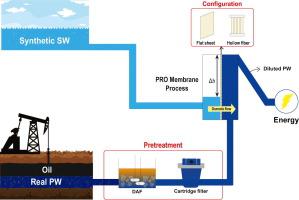Desalination ( IF 8.3 ) Pub Date : 2021-07-07 , DOI: 10.1016/j.desal.2021.115219 Dareen Dardor 1 , Mashael Al Maas 1 , Joel Minier-Matar 1 , Arnold Janson 1 , Ahmed Abdel-Wahab 2 , Ho Kyong Shon 3 , Samer Adham 1, 4

|
Pressure-retarded osmosis (PRO) is a promising membrane technology for harnessing the osmotic energy of saline solutions. PRO is typically considered with seawater/river water pairings however greater energy can be recovered from hypersaline solutions including produced water (PW) from the petroleum industry. One of the major challenges facing the utilization of hypersaline PW is its high fouling propensity on membranes. In this unique experimental evaluation, real PW from different sites was pretreated to varying degrees: i) minimal, ii) intermediate, and iii) extensive. The treated effluent was subsequently used for PRO testing and fouling rates were assessed for different membrane configurations over multiple cycles. Commercial grade flat sheet (FLS) coupons and novel hollow fiber (HF) modules were compared to validate the lower fouling propensity of HF membranes in PRO application. When minimally pretreated PW (10-micron cartridge filtration (CF)) was tested in FLS mode, severe membrane fouling occurred and the PRO flux decreased by 60%. In contrast, HF modules showed <1% flux decrease under both minimal and intermediate pretreatment schemes. Extensive pretreatment (1-micron CF, dissolved air flotation (DAF), powdered activated carbon, and microfiltration) reduced FLS PRO flux decline to <1%. These results confirm that PW can be treated to suitable levels for PRO application to avoid membrane fouling. Further validation of these pretreatment methods requires long term pilot testing and techno-economic assessment.
中文翻译:

对石油工业采出水进行压力延迟渗透应用的预处理和膜配置的评估
压力延迟渗透 (PRO) 是一种很有前途的膜技术,用于利用盐溶液的渗透能。PRO 通常用于海水/河水配对,但可以从包括石油工业产出水 (PW) 在内的超盐溶液中回收更多能量。利用高盐度 PW 面临的主要挑战之一是其对膜的高污染倾向。在这个独特的实验评估中,来自不同位置的真实 PW 被预处理到不同程度:i) 最小,ii) 中等,和 iii) 广泛。处理过的流出物随后用于 PRO 测试,并评估了多个循环中不同膜配置的污染率。商业级平板 (FLS) 试样和新型中空纤维 (HF) 模块进行了比较,以验证 HF 膜在 PRO 应用中的较低污染倾向。在 FLS 模式下测试最低限度预处理的 PW(10 微米滤筒过滤 (CF))时,发生了严重的膜污染,PRO 通量降低了 60%。相比之下,HF 模块在最小和中间预处理方案下显示出<1% 的通量下降。广泛的预处理(1 微米 CF、溶气气浮 (DAF)、粉状活性炭和微滤)将 FLS PRO 通量下降降低到 <1%。这些结果证实 PW 可以处理到适合 PRO 应用的水平,以避免膜污染。这些预处理方法的进一步验证需要长期的试点测试和技术经济评估。在 FLS 模式下测试最低限度预处理的 PW(10 微米滤筒过滤 (CF))时,发生了严重的膜污染,PRO 通量降低了 60%。相比之下,HF 模块在最小和中间预处理方案下显示出<1% 的通量下降。广泛的预处理(1 微米 CF、溶气气浮 (DAF)、粉状活性炭和微滤)将 FLS PRO 通量下降降低到 <1%。这些结果证实可以将 PW 处理到适合 PRO 应用的水平,以避免膜污染。这些预处理方法的进一步验证需要长期的试点测试和技术经济评估。在 FLS 模式下测试最低限度预处理的 PW(10 微米滤筒过滤 (CF))时,发生了严重的膜污染,PRO 通量降低了 60%。相比之下,HF 模块在最小和中间预处理方案下显示出<1% 的通量下降。广泛的预处理(1 微米 CF、溶气气浮 (DAF)、粉状活性炭和微滤)将 FLS PRO 通量下降降低到 <1%。这些结果证实可以将 PW 处理到适合 PRO 应用的水平,以避免膜污染。这些预处理方法的进一步验证需要长期的试点测试和技术经济评估。在最小和中间预处理方案下,通量降低 1%。广泛的预处理(1 微米 CF、溶气气浮 (DAF)、粉状活性炭和微滤)将 FLS PRO 通量下降降低到 <1%。这些结果证实可以将 PW 处理到适合 PRO 应用的水平,以避免膜污染。这些预处理方法的进一步验证需要长期的试点测试和技术经济评估。在最小和中间预处理方案下,通量降低 1%。广泛的预处理(1 微米 CF、溶气气浮 (DAF)、粉状活性炭和微滤)将 FLS PRO 通量下降降低到 <1%。这些结果证实可以将 PW 处理到适合 PRO 应用的水平,以避免膜污染。这些预处理方法的进一步验证需要长期的试点测试和技术经济评估。











































 京公网安备 11010802027423号
京公网安备 11010802027423号